The mechanism of Xuefu Zhuyu decoction in treating erectile dysfunction based on Arrowsmith tool
2021-05-17HaiyuanDongChaoGangGanJingyuGuoTaoLiYongHengAoWenLiLuoShilinDing
Hai-yuan Dong,Chao-Gang Gan,Jing-yu Guo,Tao Li,Yong-Heng Ao,Wen-Li Luo,Shi-lin Ding*
1First Affitiated Hospital of Yunnan University of Traditional Chinese MedivineDepartment of Urolgy and Andrology,Yunnan Traditional Chinese Medicine Hospital ,Kunming,Yunnan 650021,China.
Abstract Arrowsmith, a literature retrieval tool, was used to explore the theoretical pharmacological mechanism of action of Xuefu Zhuyu decoction and its single herb against erectile dysfunction.Cytoscape 3.6.1 software was used to analyze the correlation between the components of Xuefu Zhuyu decoction and the identified mechanism of action.Different herbs in Xuefu Zhuyu decoction may play a therapeutic role by regulating iNOS, COX-2, mTOR, Wnt, AMPK, Nrf2, TLR4, CYP2D6, BDNF, MAPK, Akt, STAT3, PI3K, ERK1, P38MAPK, JNK, VEGF, and other targets.The treatment of erectile dysfunction with Xuefu Zhuyu decoction embodied the multicomponent, multitarget, and multipathway.The Arrowsmith tool retrieval and analysis provided a scientific basis for further elucidation of the mechanism of Xuefu Zhuyu decoction against erectile dysfunction.
Key words: Arrowsmith; erectile dysfunction; mechanism; Xuefu Zhuyu decoction
Background
Erectile dysfunction (ED) is a common male disease characterized by difficulties in achieving and maintaining erection, which affects patient’s sexual life [1].The etiology and pathogenesis of ED are complex.Currently, it is believed the main causes are related to vascular and metabolic dysfunction [2].Organic ED requires drug treatment and phosphodiesterase 5 inhibitors, which are first-line drugs in western medicine.Although phosphodiesterase 5 inhibitors have apparent effects and rapid onset, they are highly-priced and impose a substantial financial burden on patients or health systems.Side effects, such as muscle pain and facial flushing, are also common.If patients have systemic symptoms due to these drugs, the achievable results may not be significant.Traditional Chinese medicine presents several treatments for ED, which became a research hotspot in recent years, with clear advantages in the overall ED therapy.
ED belongs to “impotence” category in the traditional Chinese medicine theory.Xuefu Zhuyu decoction, from the bookYilin Gaicuo(Correction on Errors in Medical Classics; 1830 C.E.), which proposed new anatomical maps, physiological perspectives and mechanisms of action for some conditions, correcting previous mistakes.Xuefu Zhuyu decoction includes Chuanxiong (Rhizoma Chuanxiong), Chishao (Radix Paeoniae Rubar), Taoren (Semen Persicae), Honghua (Flos Carthami), Niuxi (Radix Achyranthis Bidentatae), Dihuang (Radix Rehmanniae), Chaihu (Radix Bupleuri), Zhike (Fructus Aurantii), Jiegeng (Radix Platycodonis) and Danggui (Radix Angelicae Sinensis).It promotes blood circulation, eliminates blood stasis, and regulates Qi.Taoren (Semen Persicae) and Honghua (Flos Carthami) in the formula could remove blood stasis, and the two drugs supplement each other for a total of sovereign (Jun) drugs.Chishao(Radix Paeoniae Rubra), Chuanxiong (Rhizoma Chuanxiong) and Niuxi (Radix Achyranthis Bidentatae) are known for promoting blood circulation, counteracting blood stasis, and relieving pain.Dihuang (Radix Rehmanniae) and Danggui (Radix Angelicae Sinensis) could nourish blood Yin, clear heat, and activate blood circulation.Chaihu (Radix Bupleuri), Zhike (Fructus Aurantii), and Jiegeng (Radix Platycodonis) is believed to sooth the liver and regulate Qi.Radix Platycodoniscarries medicine upwards, andRadix Achyranthis Bidentataeguides blood down,Radix Glycyrrhizacoordinates all drugs.This prescription is widely used in the treatment of andrologic diseases.Its complex components have the characteristics of traditional Chinese medicine—multicomponent,multitarget,and multipathway—in treating illness.At present, the mechanism of action of Xuefu Zhuyu decoction for the treatment of ED has not been fully elucidated.
Arrowsmith knowledge retrieval has been widely used in biomedical research in recent years [3].Based on a large number of literature datasets, the identification of associations provided clues and ideas for clinical or experimental research.Therefore, based on a PubMed database literature, we used the Arrowsmith tool to find standard correlation terms between subject headings on known literature, which could be extended to WOS, Embase, CNKI, and other databases [4].We used the correlation analysis of the literature to explore the mechanism of action of Xuefu Zhuyu decoction and its single herb against ED.
Literature retrieval using Arrowsmith
Arrowsmith (http://arrowsmith.psych.uic.edu/) online retrieval interface was used on September 10th, 2020.The retrieval words in the subject of A collection were “Xue Fu Zhu Yu Tang” or single flavor medicine, such as peach walnut (“Semen Persicae” or “taoren”), and the retrieval words in the subject of C collection were “Erectile Dysfunction.” After connecting A and C sets with the Arrowsmith tool to form a B set, the association word was set.To eliminate the undesired field-related words, the semantic filter was used to select Chemicals & Drugs, Disorders, Genes & Protein Names, Gene & Protein Sequences, and the remaining related terms were formed into a new set B.Then irrelevant terms were manually excluded.The relevant statistics are shown in Table 1.
Comprehensive analysis of literature retrieval results
By determining the word bank correlation of a single drug, the top 20 related words were selected for analysis.At least two or more associated words were chosen for Xuefu Zhuyu decoction or its single herb.Cytoscape3.6.1 software was used to visualize the essential correlation.
Analysis of Single Herb and ED
Analysis of Semen Persicae and ED.Semen Persicae, or peach kernel, promotes blood circulation, removes blood stasis, moistens bowel laxity, and relieves cough and asthma.It is a common herb for the clinical treatment of blood stasis block.The related words (gene or protein) of ED in peach kernel treatment include nitric oxide synthase, inducible nitric oxide synthase(iNOS),cyclooxygenase-2(COX-2), endothelin-1 (ET-1), and apolipoprotein E (ApoE), as shown in Table 2.The main components of peach kernel are lipid-soluble substances, proteins, sterols, glycosides, flavonoids, and phenolic acids [5].
Vascular endothelial dysfunction and atherosclerosis are important in the pathogenesis of ED [6].Some studies have found that the cavernous artery, the cavernous smooth muscle, and endothelium presents structural changes in diabetic patients [7].ED is considered an indicator of systemic endothelial dysfunction and a sentinel of asymptomatic systemic cardiovascular disease [8].Fermino Sanches Lizarte Neto et al.[9] studied the iNOS gene and protein expression in the cavernous smooth muscle of alcoholic, diabetic, and alcoholic diabetic rats.NO and iNOS are involved in inflammatory regulationin vivo.NO generation by iNOS plays an essential role in inflammatory responses and tissue repair, inducing both inflammatory and cytotoxic effects [10−12].Amygdalin (AGD) is one of the main active components of peach kernel glycosides and has antiinflammatory activity.AGD inhibits the expression of COX-2 and iNOS and reduces the inflammatory response [13].AGD also improves the inflammatory response by inhibiting the production of inflammatory factors, including iNOS and COX-2 [14].ET-1, a potent vasoconstrictor peptide, is involved in the physiopathology of ED and is key component in the pathogenesis of ED mediated by hypercholesterolemia and diabetes [15−17].A study also showed that the level of ET-1 in peripheral blood and cavernous blood in the ED case group was higher than in healthy controls [18].Zhang et al.[19] treated chronic pancreatitis with AGDin vivo, and found that AGD may improve pancreatic microcirculation by downregulating ET-1.Peach kernel compounds could also inhibit significantly the expression of ET-1 in rabbit serum and improve hemorheology [20].The same compounds were able to induce development of mature plaques in ApoE gene-deficient mice, stabilizing the plaques to some extent.This mechanism may be related to the regulation lipid metabolism and inhibition of the inflammatory response [21].
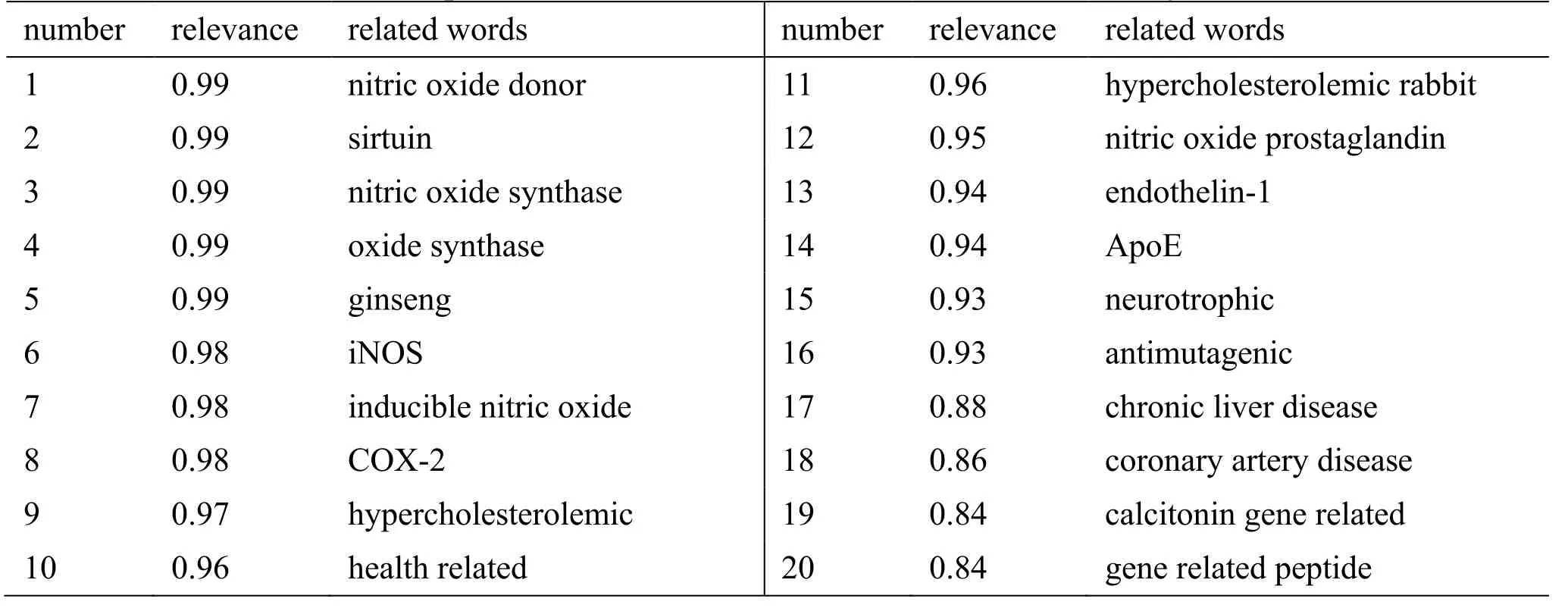
Table 2 The top 20 related words of Semen Persicae and erectile dysfunction
Analysis of Flos Carthami and ED.Flos Carthamihas the effect of promoting, or safflower, can promote blood circulation, disperse circulation, disperse blood stasis and relieve pain.Clinically, the medicinal herb has been used to improve micro-vascular diseases, such as coronary heart disease and angina pectoris.The related words (gene or protein) of ED in safflower therapy included NF-E2-related factors (Nrf2), Toll-like receptor (TLR4), iNOS, COX-2, and cytochrome P4502D6 (CYP2D6), as shown in Table 3.The main components of safflower are flavonoids, alkaloids, polyacetylene, arginine, and lignans [22].
Previous studies have shown that TLR4 was associated with vascular homeostasis and vascular dysfunction in chronic diseases [23].It was also found that TLR4 mediates vascular diseases, such as diabetes [24], hypertension [25], and vascular ED [26].COX-2 regulates prostaglandins, which play an essential role in inflammation and are controlled by TLR4 signals [27, 28].TLR4 and COX-2 expressions were significantly increased in ED model rats [29].Kenia Pedrosa Nunes et al.[30] found that long-term inhibition of TLR4 could slightly improve diabetic-induced ED in rats.Studies have shown that the aqueous extract of safflower has potent antioxidant activity [31].Dan Han et al.[32] observed that hydroxyl safflower yellow pigment A alleviated the inflammatory damage in hyperlipidemia rat models by inhibitingTLR4signal transduction.The spongy tissue of ED patients showed reduced Nrf2 and increased superoxide content [33].Nrf2 is a central regulator that coordinates cells’ response to oxidative stress and protects the endothelium from injury by upregulating some effector enzymes [34].A study also showed that the deletion of theNrf2gene in rats could lead to endothelial dysfunction,oxidative stress,and microvascular changes [35].Javier Angulo et al.[33] found thatNrf2activation could improve endothelial dysfunction and enhance ED conventional drug therapy in human target tissues.It is known that safflower can significantly enhance Nrf2 [36].Zhang et al.[37] used safflower extract combined with aceglutamide injection in a brain injury rat model.The results showed that aceglutamide injection enhanced the Nrf2 system, inhibited the activation of apoptosis signal-regulated kinase 1, prevented the subsequent activation of p38 and C-Jun amino-terminal kinase (JNK) signaling cascade, and reduced oxidative damage and cell apoptosis.Liu Feng et al.[38] proved that safflower extract could inhibit the subtype CYP2D6 in rats, suggesting that adverse effects may be avoided when combined with other drugs affecting the CYP2D6 metabolism.
Analysis of Fructus Aurantii and ED.Fructus Aurantiiregulates Qi and eliminates distension.The associated proteins (genes or proteins) in ED treatment ofFructus Aurantiii, include protein kinase B (Akt), AMP-activated protein kinase (AMPK), brain-derived neurotrophic factor (BDNF), and mitogen-activated protein kinase (MAPK), as shown in Table 4.The main components ofFructus Aurantiii are volatile oils, flavonoids, coumarins and alkaloids [39].
The PI3K-Akt-MTOR pathway regulates various cellular processes,including cell apoptosis, proliferation, and metabolism, and has been shown to be vital in the generation of vascular endothelial cells [40].Naringin, a flavonoid present inFructus Aurantiii, inhibits autophagy by activating the PI3K-Akt-MTOR pathway to improving endothelial cell dysfunction, a possible protection and treatment for diabetic vascular diseases [41].The PI3K/Akt signaling pathway also regulates fat formation [42−43].AMPK is a critical point in metabolic and catabolic pathways and a classic target for diabetes treatment.P-syringolin is a primary alkaloid inFructus Aurantiii [44].It has been found that through the activation of the Akt pathway, P-syringolin acted as antilipid with protective effect against damage in the vascular system [45].Acid heterosaccharide ofFructus Aurantiii was found to activate Akt to play the same role [46].Limonene, one natural product of the volatile essential oil inFructus Aurantiii, was able to regulate fat formation and blood glucose through the Akt signaling pathway and increase AMPK content [47, 48].In conclusion, the practical components ofFructus Aurantiican be important in the treatment of metabolic diseases by targeting Akt and AMPK.Nf-κB comprises a variety of cytokines including the tumor necrosis factor-alpha, IL-1β, and IL-6, involved in the regulation of the inflammatory process factor [49].MAPK is also involved in the inflammatory process.Evidence suggests that the MAPK family (including p38MAPK, ERK and JNK) plays an essential role in signal transduction pathways and mediates a variety of physiological and pathological changes in cells.Therefore, the inhibition of NF-κB and MAPKs may have potential therapeutic effects in inflammatory diseases [50].Limonene was shown to reduce the production of proinflammatory cytokines by inhibiting the activation of NF-κB and MAPK [51], andFructus Aurantiiinhibited MAPK and NF-κB signaling pathways and activated the AMPK signaling pathway, causing a significant decrease in the inflammatory response, oxidative stress, and apoptosis [52].BDNF, a member of the neurotrophic factor family, activates the JAK kinase/signal transduction and transcriptional activator pathway in Schwann cells, which mediates the effect of nerve regeneration after penis-spongiform nerve injury [53−55].Lujie Song et al.[56] proved that BDNF could enhance the recovery of erectile function and inhibit penile cavernous fibrosis after cavernous nerve injury.Additionally, naringin was able to upregulate BDNF expression [57].
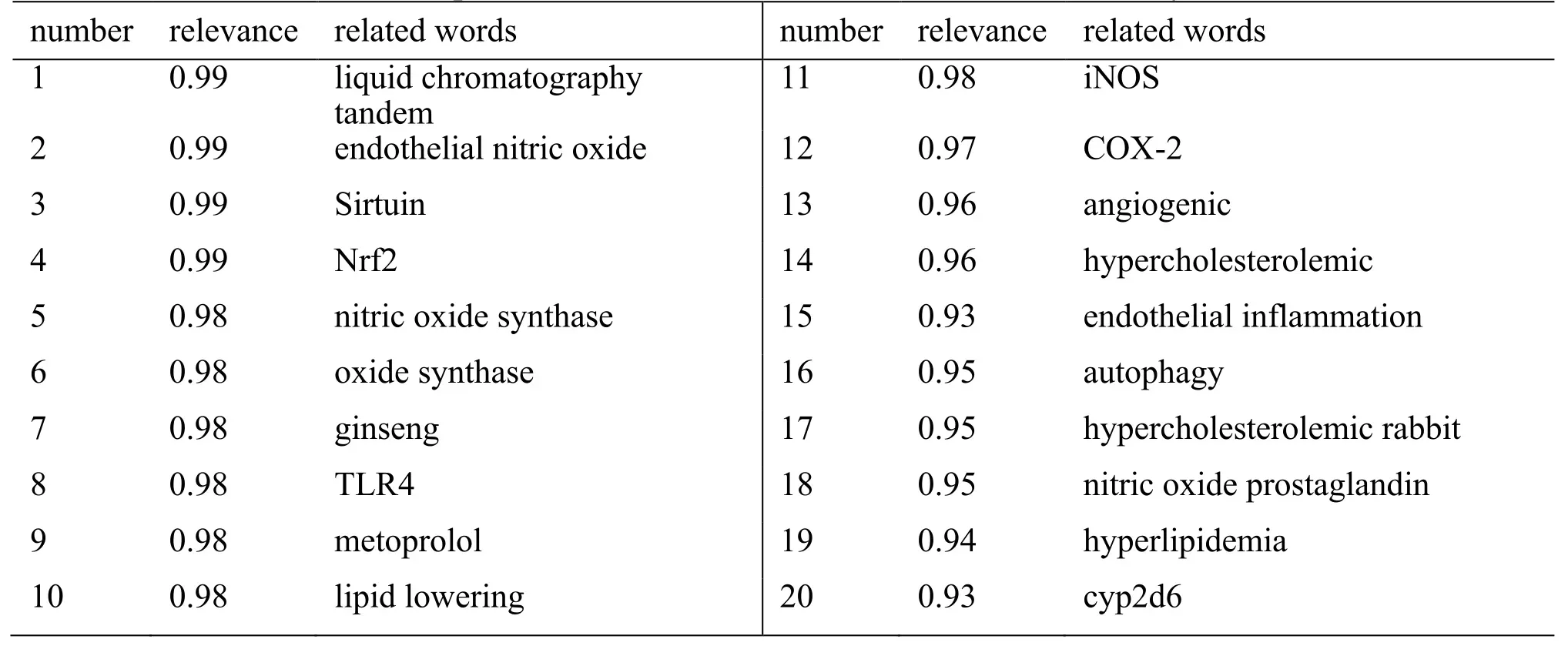
Table 3 The top 20 related words of Flos Carthami and erectile dysfunction
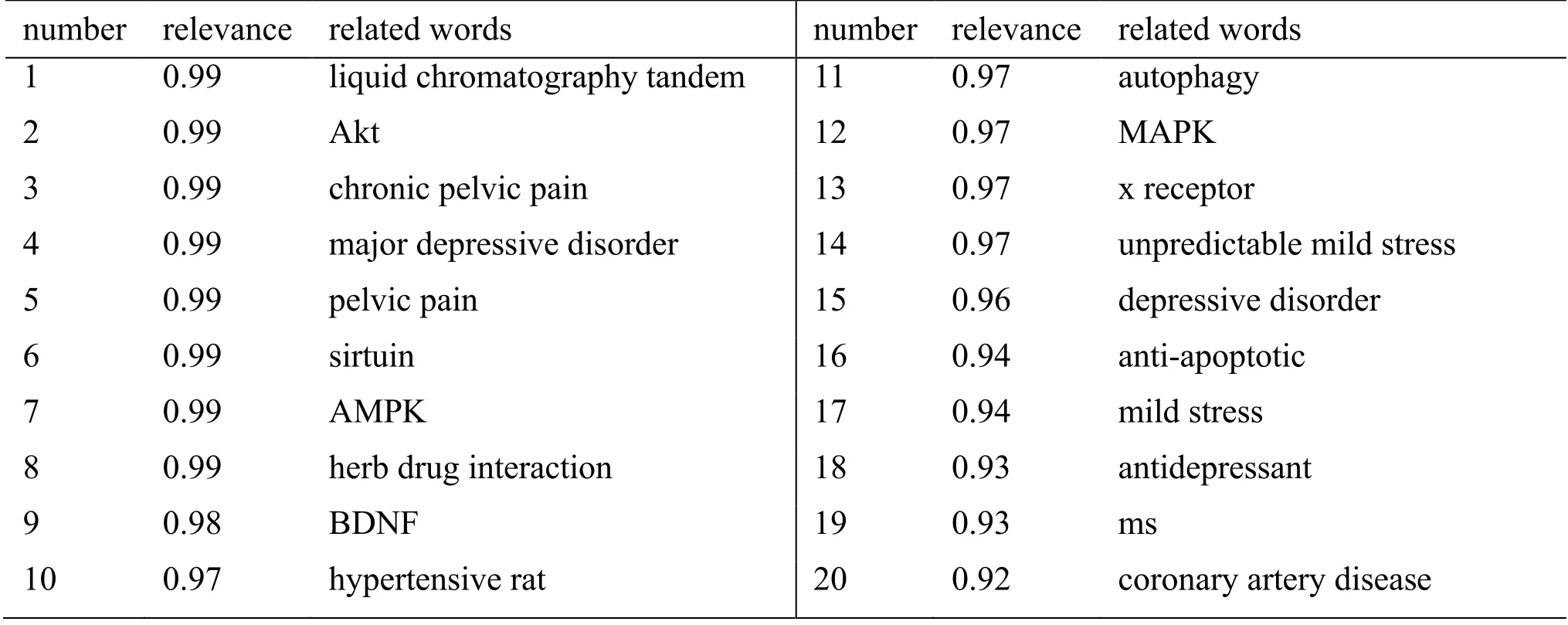
Table 4 The first 20 related words of Fructus Aurantii and erectile dysfunction
Analysis of Radix Rehmanniae and ED.Radix Rehmanniaenourishes Yin, clears heat, cools blood, and enriches the blood.The related words (gene or protein) for the treatment of ED included Akt, mammalian target of rapamycin (mTOR), Wnt signaling pathway, phosphatidylinositol-4, 5-bisphosphate3-kinase (PI3K), TLR4, MAPK, ERK, CYP2D6, and COX-2, as shown in Table 5.The main components ofRadix Rehmanniae, include iridoid, glycosides, glycosides, and amino acids [58].
Catalpa alcohol, an iridoid glycoside extracted fromRadix Rehmanniae, has been shown to improve endothelial dysfunction by inhibiting the NF-κB/iNOS pathway and activating the PI3K/Akt/eNOS pathway [59].In addition, catalpa inhibited the expression of TLR4, iNOS, and COX-2, and the production and presentation of proinflammatory cytokines [60, 61].Cavernous fibrosis also contribute for the deterioration of the erectile function.Altered or dysregulated Wnt activity in adults is associated with pathological angiogenesis, atherogenesis, and tissue fibrosis [62−64].S.H.Shin et al.[65] demonstrated the differential expression of Wnt family members in the penis of diabetic mice and speculated that modulation of the Wnt pathway might represent a novel therapeutic target for the treatment of diabetic ED.Total glucoside from leucoside was able to inhibit renal fibrosis by regulating the Wnt/-catenin signaling pathway [66].PI3K/AKT/mTOR pathway was also involved in inflammatory, oxidative stress, cellular fibrosis, and other pathological processes [67−69].Catalpa significantly activated the PI3K/Akt/mTOR signaling pathway and inhibited oxidative damage and cell apoptosis [70].Rehmannia showed a significant dose-dependent inhibition on the PROBE substrate in a CYP2D6 model [71].
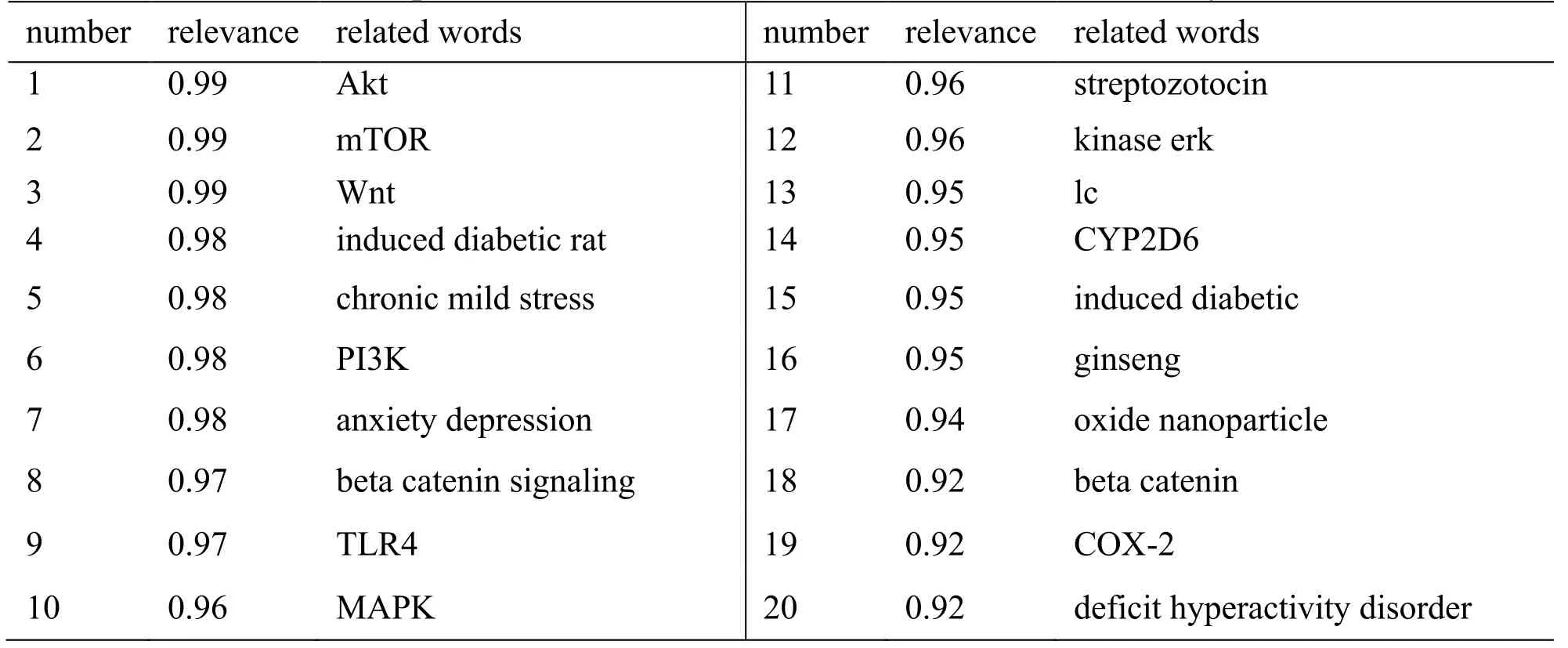
Table 5 The top 20 related words of Radix Rehmanniae and erectile dysfunction
Analysis of Radix Bupleuri and ED.Radix Bupleuri, or Buchaihu, contributes for dispelling appearance, soothing liver, and relieving depression, by raising Yang to lift depression, and reducing fever and malaria.mTOR, Nrf2, TLR4, iNOS, signal transducer and activator of transcription 3 (STAT3), BDNF, MAPK, and Caspase-3 were related words (gene or protein) of ED treated by Buchaihu, as shown in Table 6.The active ingredients ofRadix Bupleuriinclude saikosaponin A, saikosaponin D (SSd), quercetin, and kaempferol.[72].
Saikosaponin A inhibits the level of inflammatory factors, the expression of COX-2 and iNOS in inflammatory endothelial cell models, reduces TLR4 dimerization and lipid raft translocation, presents anti-inflammatory and antioxidant effects [73], and upregulates the BDNF expression [74].SSd and quercetin upregulate Nrf2 expression, reducing inflammation [75, 76], and theRadix Bupleuriextract can improve the antioxidant capacity by activating the Nrf2 signaling pathway [77].Bupleuri polysaccharides can inhibit the TLR4 signaling pathway, present anti-inflammatory activity, and contribute to the immune regulation [78].STAT3 is a transcription factor.Phosphorylation of STAT3, a transcription factor, regulates the transcription of a series of targeted genes and plays an essential role in the PDGFR/STAT3 signaling pathway, involved in ED’s pathogenesis and often associated with atherosclerosis [79].In addition, STAT3 is known to be involved in COX-2 protein expression regulation [80].SSd can significantly inhibit STAT3 phosphorylation, thereby inhibiting COX-2 expression [81].Quercetin shows antifibrotic activity by inhibiting fibrogenic factors and the AKT/mTOR signaling pathway [82].The caspase family is essential for cell apoptosis, particularly for the effector enzyme Caspase-3, located in the apoptotic pathway [83].SSd can trigger apoptosis by activating Caspase-3 to delay fibrosis [84].
Analysis of Radix Glycyrrhiza and ED.Radix Glycyrrhiza, or licorice, is able to tonify the spleen, invigorate Qi, clear heat, detoxify, expectorate phlegm, relieve cough, relieve pain, and harmonize all kinds of drugs.The role of licorice on the treatment of ED is still unknown.The Arrowsmith tool is based on the available literature and finds relevant target information through literature correlation.Therefore, no related proteins or genes were found in the intersection target of the licorice root and ED.The main components or licorice are flavones and saponins [85].
Analysis of Radix Angelicae Sinensis and ED.Radix Angelicae Sinensisis believed to enrich blood, activate blood circulation, regulating menstruation, relieve pain, moisten bowel, and constipation.The related words (gene or protein) of ED treated by angelica, include Akt, eNOS, PI3K, ERK1, Nrf2, p38MAPK, MAPK, and JNK, as shown in Table 7.The main active components ofRadix Angelicae Sinensisare the volatile essential oil, organic acids, polysaccharides, and flavonoids [86].
Nitric oxide (NO) is a critical factor in regulating endothelial function.Phosphorylation of Akt promotes endothelial nitric oxide synthase (eNOS) in endothelial cells to protect the endothelium.Angelica polysaccharides can regulate NO levels and protect vascular endothelium through VEGF/Akt signaling [87], and reduce Nrf2 protein expression [88].Ferulic acid (FA), one of angelica’s organic acids, has anti-inflammatory and antioxidant activity.The combination of FA and astragaloside IV was able to promote NO and eNOS release and to have a significant protective effect on vascular endothelial dysfunction in diabetic rats [89].FA’s antioxidant role is thought to be due to activation of the Nrf2 pathway mediated by ERK1/2 [90], promoting the activation of PI3K/AKT signaling pathway [91], and inhibiting phosphorylation of MAPKs, including P38 and JNK [92].
Analysis of Rhizoma Chuanxiong and ED.Rhizoma Chuanxiongpromotes blood circulation, dispels wind, and relieves pain.The related words (gene or protein) of ED treated byRhizoma Chuanxiongwere vascular endothelial growth factor (VEGF), Akt, and Nrf2, as shown in Table 8.The active ingredients ofRhizoma Chuanxiongare volatile essential oils, alkaloids, and polysaccharides [93].
In diabetic or hypercholesterolemic ED animal models, VEGF can effectively target penile angiogenesis [94].Ligustrazine is a lacustrine alkaloid that may inhibit angiogenesis, by inhibiting VEGFR2 expression [95] and activate PI3K/Akt [96].Studies have shown that [97] Chuanxiong and its active components can affect PI3K-Akt, a signaling pathway closely related to vascular endothelial injury with blood stasis syndrome.VEGF expression significantly promotes the tubulogenesis and proliferation of endothelial progenitor cells [98].Jingchang Du [99] found that the volatile oil ofRhizoma Chuanxiongwas able to upregulate the expression of VEGF.Ligustilide, the main component of the volatile oil of Ligusticum Chuanxiong, inhibits the expression of Akt/NF-κB signaling [100].Ligusticonolactone can activate the Nrf2 pathway by upregulating the phosphorylation of ERK1/2 [101].
Analysis of Radix Platycodonis and ED.Radix Platycodoniscan promote the lung, benefits the pharynx, eliminates phlegm, and dischares pus.Radix Platycodonistreatment ED associated words (genes or proteins) were Wnt, Akt, mTOR, STAT3, Erk1, VEGF, p38 MAPK, PI3K, JNK, MAPK, CYP3A, JAK-STAT, Lname, Nrf2, BDNF and iNOS, as shown in Table 9.The primary chemical constituents ofRadix Platycodonisare triterpenoid saponins, flavonoids, phenolic acids, and polyalkenes [102].
Platycodin, the main active component ofRadix Platycodonis, can downregulate VEGF expression [103] and regulate the proliferation and metastasis of vascular endothelial cells.It also activates AMPK/PI3K/Akt signaling pathway and inhibits the NF-κB signaling pathway toward its antiapoptosis, antiinflammatory, and antioxidant activities [104, 105].Platycodin D inhibits vascular endothelial cells’ proliferation due to the phosphorylation of ERK1/2, P38 MAPK, and JNK [106].Platycodin D can also regulate the Wnt pathway, protecting blood vessels [107], and activate ERK to trigger autophagy [108].Consequently, NF- B and JAK2/STAT3 pathways are inhibited [109] as well as the expression of iNOS and iNOS mRNA [110].Furthermore, Nrf2 expression can be activated [111] and BDNF upregulated [112].Additionally, CYP450 is involved in the biosynthesis ofRadix Platycodonisand presents an antioxidant role [113].
Analysis of Radix Achyranthis Bidentatae and ED.Radix Achyranthis Bidentataeis believed to promote blood stasis and passing through meridians, strengthening muscles and bones of liver and kidney, diuresis and circulation, and drawing blood down.The related word (gene or protein) ofRadix Achyranthis Bidentataeand treatment ED was Wnt (Table 10).Its main active components of this root are polysaccharides, saponins, and phytosterols [114].Kalyan Ghatak et al.found that Wnt signaling antagonists could restore erectile function in experimental mice by inducing nerve regeneration and angiogenesis [115].Zhang et al.found that the active ingredients ofRadix Achyranthis Bidentataehave a significant inhibitory effect on endothelial cell proliferation [116].It is speculated that theRadix Achyranthis Bidentataemay play a role through the Wnt pathway by significantly inhibiting vascular endothelium proliferation.
Radix Paeoniae Rubar and ED analysis.Radix Paeoniae Rubarhas the following effects: clearing heat and cooling blood, dispersing blood stasis, and relieving pain.No clear target was found with this root, and its active ingredients are mainly monoterpenes and their glycosides [117].Paeoniflorin can inhibit the expression and secretion of inflammation-related proteins and chemokines and improve inflammatory endothelial cells [118].Studies have also shown that [119] paeoniflorin has a strong effect on improving hemorheology abnormalities and protecting vascular endothelial function.

Table 8 The top 20 related words of Rhizoma Chuanxiong and erectile dysfunction

Table 9 The top 20 related words of Radix Platycodonis and erectile dysfunction
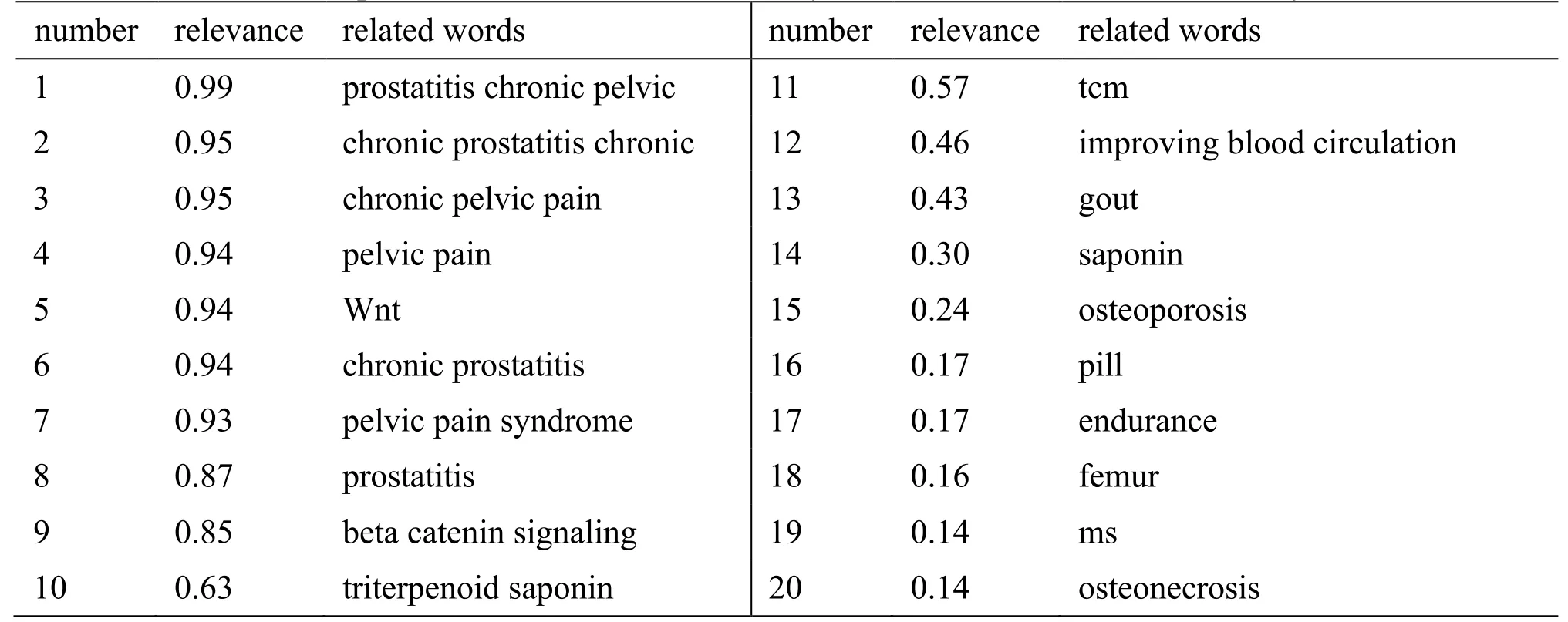
Table 10 The top 20 related words of Radix Achyranthis Bidentatae and erectile dysfunction
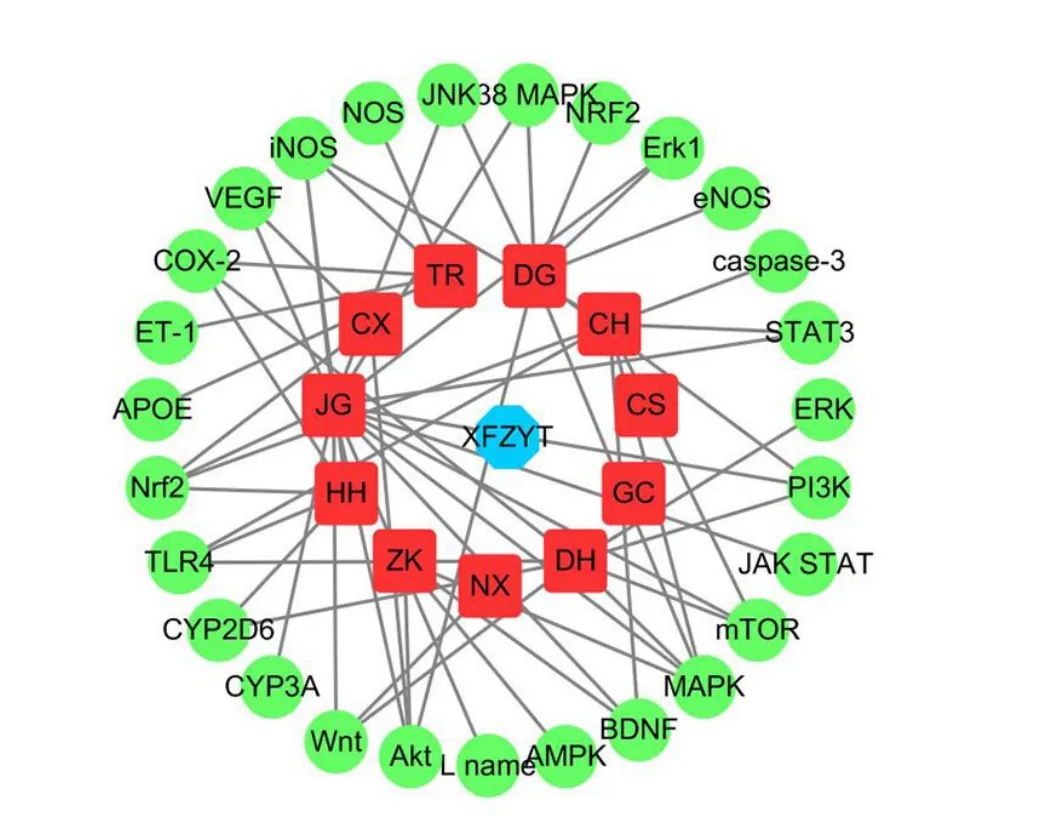
Figure 1 Analysis of common targets of Xuefu Zhuyu decoction and its single drug in the treatment of erectile dysfunction
Analysis of Xuefu Zhuyu decoction and ED
Xuefu Zhuyu decoction is a representative prescription for promoting blood circulation and avoiding blood stasis.This decoction is believed to have good efficacy in treating of ED, but there are no studies on its actionin vivo.The main gene or protein associated with the treatment of ED is VEGF.VEGF can enhance vascular permeability, promote neovascularization, stimulate the proliferation and metastasis of vascular endothelial cells.Xuefu Zhuyu decoction was able to regulate the proliferation and apoptosis of smooth muscle cells [120].
Analysis of common targets
As shown in Figure 1, the typical marks of Xuefu Zhuyu decoction and its single drugs are iNOS, COX-2, mTOR, Wnt, AMPK, Nrf2, TLR4, CYP2D6, BDNF, MAPK, Akt, STAT3, PI3K, ERK1, P38MAPK, JNK, and VEGF.These targets are involved in pathways and contribute to the inhibition of the inflammatory response, reduction of apoptosis, and protection of vascular endothelial cells.
Discussion
ED is a chronic physical and psychological disease with a severe impact on its patients.The etiology and pathogenesis of ED are complex.Currently, it is believed the main causes are related to vascular and metabolic dysfunction [2].In recent years, we have gained a deeper understanding of ED’s pathophysiology.Many emerging therapies, such as angiogenesis therapy, aim to treat vascular and spongiform injuries, to regenerate new penis tissue [121].As a classic prescription, more clinical trials have proved that Xuefu Zhuyu decoction has a good effect in treating ED.
In this study, the Arrowsmith tool was used to correlate Xuefu Zhuyu decoction and its single herbs with ED literature.It was found that Xuefu Zhuyu decoction and its single herbs had an indirect therapeutic effect on ED based on multiple components, multiple pathways and various targets.Besides, among the 17 common targets, mTOR, Wnt, iNOS, COX-2, Nrf2, TLR4, BDNF, MAPK, Akt, PI3K, and other targets had a high degree of common correlation, providing an entry point for subsequent analysis of the therapeutic ED mechanism of Xuefu Zhuyu decoction and its single herbs.This study on different and common targets also provides new data toward the compatibility and synergistic effect of traditional Chinese medicine.
